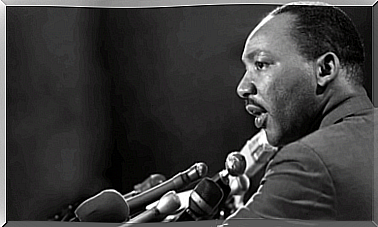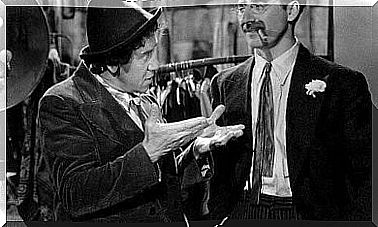Distance And Body Language Between Interlocutors

The physical distance that exists between two interlocutors “speaks” in itself of the type of relationship they share. Indeed, although silent, body language sometimes says more than words. At least, it often complements what we try to convey in words. In addition, in order to communicate well two people need to be face to face. The technological age in which we now live has not changed this state of affairs, but e-mails, chats and other online messaging leave less room for this essential aspect of communication.
Non-verbal language is indeed a determining factor in the transmission of a message. However, what is the best distance to take to establish effective communication?
A universe of gestures
The universe of gestures, movements and micro-movements is part of non-verbal language. This means that the gesture can be considered as the basic unit of this type of language. It is defined as a position or movement of the hands, face or other parts of the body that is used to establish direct and immediate communication with another person.
Gestures are a means of communication in their own right
The gesture can be considered as an expressive movement of psychic contents. That is to say that the gestures are muscular movements that seek to express themselves. And they do, whether it is voluntary with deliberate intention or whether it is the unintentional result of an unconscious dynamic.

The facial expressions and gestures are extremely complex. They generally escape any kind of precise measurement. It is the same with micro-movements almost imperceptible to conscious perception. It is therefore very difficult to achieve a global and complete appreciation of the gestural universe.
In the world of human interactions, the gesture is a symbolic movement that expresses and demonstrates something. However, it must be deciphered. In other words, the gesture is a message to be interpreted. Each interlocutor can decode the gestures of the other according to his own beliefs, his values or his personal meanings. But also the knowledge we have of the other person and the context in which the dialogue takes place.
Non-verbal language therefore includes movements of the face, chest and hands, but also the use of space and all our body postures. This language represents a spontaneous element in the transmission of the message. However, it is often a resource that is marginalized or relegated to the background of verbal language.
Nevertheless, we have become accustomed not only to listening to our interlocutor, but also to observing him. The need to see the interlocutor while speaking is often unconscious. That is to say, we are not aware of the fact that we need to see our interlocutor in order to understand him in the whole dimension of the message he is trying to convey to us. Notice that when we communicate, we say “I hear you” and not “I see you”.
The different types of distance possible between interlocutors
The gestures, the bodily expressions, the tone of the speech, the cadence and the rhythm, the movements carried out all develop in a space delimited between the interlocutors. This space itself is important so that two (or more) people can establish an effective conversation.
Hall (1966) distinguishes the treatment of space and movement in relation to this relational proximity or estrangement. He classifies them into 4 types of distances.
The intimate distance
It implies a distance of emotional proximity. This is typically the distance chosen by a couple in the romantic relationship. It is also the filial distance. For example during a hug between a father and his son. It is the proximity that allows the fusion of interlocutors. It is also, to a certain extent, the breaking of the personal territorial limit. This space invites you to express yourself emotionally. For example, by kissing or caressing the body of the other.
Personal distance
It is a distance of proximity, but within which the interlocutors maintain their personal borders. In other words, personal boundaries are clearly defined and not crossed. It is the distance of interpersonal relationships between friends, between relatives of the same family or between work colleagues. It is also the appropriate distance between two people who have a common goal or interest.
Social distance
This type of distance does not include any physical contact. Indeed, it is the gaze which predominates and which constitutes the only possible type of link. This is not, however, an impersonal relationship. It’s just that a protective space separates the interlocutors from possible invasions or intrusions on the part of the other. This is the appropriate distance in negotiation and sales contexts. In general, the space between the interlocutors is occupied by a desk, a display, a table, or other objects which impose a certain distance between the speakers. For example, in a psychiatric practice, it is typically the therapeutic distance that implies the presence of the desk, the white coat, etc.
Public distance
It is the distance of formal relations. There is no privacy, let alone a personalized bond. Any type of direct relationship is banned. This is the usual distance from the professor or lecturer.
Factors having an influence on the distance between interlocutors
In the last 3 types of distances mentioned above – namely personal, social and public distance – the measure of the space between the interlocutors varies between 60 and 80 cm. This generally corresponds to a door or hallway width.
The environmental aspect
In this way, architecture in a certain way imposes our ways of life and interaction. For example, interior doors are generally narrower than those leading to the exterior. This is the case for houses fitted out according to the particular requirements of each family, but also for impersonal constructions of public buildings.
Indeed, the contemporary interior doors, as well as the corridors, have a width of about 65 cm. While entrance doors normally measure 80 cm. Likewise, although the constructions of the first half of the 20th century were characterized by interior doors wider than those of today, the exterior doors were often double leaf.
We can therefore put forward the following hypothesis. Although today we live in a time when relationships are more impersonal, personal, social and public distances have been reduced. This situation contrasts with that of the first decades of the last century. Thus, at that time, despite the fact that the interactions were closer and closer (neighborhood neighbors, more time devoted to friends and family), the imposed distance was intended to be more formal. The physical contact was therefore less acceptable and the relational distance was much greater than it currently is.
The cultural aspect
However, relational distance also depends on the socio-cultural context. Each culture imposes on its members a type of space between interlocutors. In some cultures, a certain social distance equals an intimate distance in other cultures. This can obviously create communication misunderstandings in an international context. This is especially true in cases where the culture dictates that speaking comes with some level of physical contact.

An example of the distance between interlocutors in the socio-cultural context
An example, referred to by Paul Watzlawick (1976), illustrates these cultural differences. Thus, researchers carried out a study at the Rio de Janeiro airport in Brazil. At that time, the airport had a terrace with a slightly inclined access ramp. This ramp had been the subject of a number of accidental falls in recent years. C es accidents involved mainly European who were then accompanied by Brazilians.
This terrace served as a meeting place for reunions and farewells of passengers. The researchers discovered that in this type of situation the average distance between a Brazilian and a European almost corresponded to the intimate distance according to European criteria. The latter, sometimes uncomfortable, therefore tended to move back in order to maintain a space that suited them in the face of the emotional demonstrations of their Brazilian interlocutors. The Brazilians responded by moving forward in search of their own social distance. This is how some Europeans ended up falling because of the slope of the access ramp.
Conclusions
Beyond the distance between interlocutors that culture imposes on us, each of us also establishes our own standards in terms of spacing with the other. However, the standard distance of 80 cm allows you to have a global view of the interlocutor. This makes it possible to observe the whole body of the person by means of peripheral vision. And this, in order to be able to appreciate the gestural messages sent to us.
Finally, the gestures are indomitable. Indeed, even if it is possible to consciously control what we express verbally (except for missed acts!), It is impossible to control our actions.
Thus, when the interpretation of the message of others is subject to doubt, it may be wise to be aware of our communicational distance and the metacommunication of our interlocutors in order to remove the uncertainty. It is about recognizing certain codes in order to promote healthy and effective communication.









